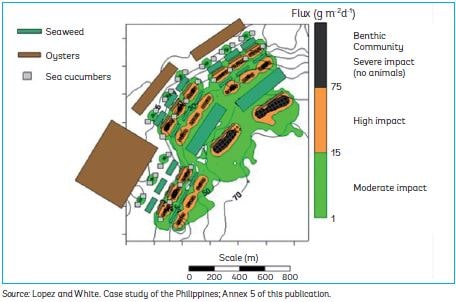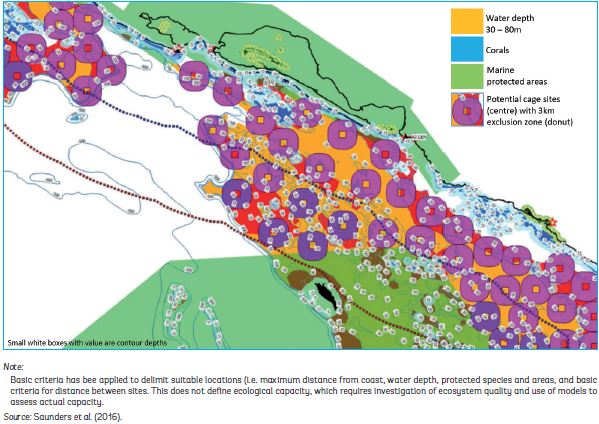6.3. Carrying capacity and environmental monitoring of AMAs
Estimates of environmental carrying capacity of the area should be made and regular surveys conducted to reassess the area. Carrying capacity at the AMA scale could be undertaken, for example, using depositional models (particle tracking) that predict the particulate outputs from fish cage aquaculture and that can be used in local-scale assessment of the effects of fish cages on the organic footprint impact on the sediment and sensitive demersal flora and fauna.
Particulate tracking models use the output from a spatially explicit hydrodynamic-dependent particle tracking model to predict (organic) flux from culture sites to the bottom. At the local scale, screening models may be used to look at aquaculture yields,local impacts of fish farming and water quality.
Figure 7 shows the modelled sediment impact below a cluster of fish farms in Panabo Mariculture Park, the Philippines, based on the existing situation (2012) and proposed rearrangement of the layout to increase production while trying to minimize impact.
FIGURE 7. Output from a particulate waste distribution model (TROPOMOD) developed for fish cage culture, which provides a footprint of organic enrichment beneath clusters of fish farms (Panabo Mariculture Park, the Philippines)

Regular environmental monitoring surveys of individual farms for local impact and aquaculture area monitoring for clusters of farms are needed. In Turkey, aquaculture zones are monitored using the TRIX index, which is a measure of eutrophication, and is a tool for the regulation of Turkish marine finfish aquaculture to protect coastal waters, especially those of enclosed bays and gulfs from pollution by fish farming.
Environmental monitoring systems are essential to address climatic variability and climate change (Box 2).
BOX 2
Area-based environmental monitoring systems to address climatic variability and climate change Even though each farmer may collect some information and may have access to meteorological forecasts, these may not be enough for early warning on local extreme events. Simple information collected and shared on a permanent basis (e.g. water temperature, oxygen, transparency, water level, fish behaviour, salinity) can be highly relevant for decision-making, especially when changes can produce dramatic consequences. For example, temperatures above or below average can trigger diseases, or can bring anoxic water to the surface or trigger algal blooms that kill fish. The monitoring of environmental variables such as oxygen and water transparency can also indicate excessive nutrient output from farms, etc. The sharing of monitoring information in common areas combined with early warning systems can assist rapid response to diseases and other threats such as algal blooms and anoxic bouts. In general, environmental monitoring systems should follow a risk-based approach that recognizes that increased risk requires increased monitoring efforts. The involvement and value of locally collected information should be seen as very relevant to farmers to better understand the biophysical processes and become part of the solution, e.g. rapid adaptation measures and early warning, long-term behavioural and investment changes. Key activities include training of local stakeholders on the value of the information, monitoring, and use of the feedback for decision-making. It is also advisable to provide/implement some simple network/platform to receive and analyse the information, to coordinate and connect with broader forecasts and monitoring systems, and to provide timely feedback that is useful to local stakeholders. In such cases, well organized AMAs can generate information and facilitate feedback for faster responses.
A recent consultation on developing an environmental monitoring system to strengthen fisheries and aquaculture resilience and improve early warning in the Lower Mekong Basin took place in Bangkok, Thailand, in 2015 (FAO, 2017).
6.3.1 Some key actions to establish ecological carrying capacity and maximum allowable aquaculture production in aquaculture zones and aquaculture management areas
1. Define the boundaries of the aquaculture zone or aquaculture management area, considering it as an ecosystem unit. In freshwater systems boundaries are generally physical boundaries such as a river basin, a water catchment, a lake or oxbow lake. Boundaries in marine systems for enclosed bays or Fjordic systems can be defined as the point at which they connect with the open sea, and are easier to define than an open coastal zone or offshore area.
The latter marine cases may require operational boundaries such as a current border or a sharp change in hydrography, oceanographic conditions or benthic morphometry.
2. Establish baseline conditions for the aquaculture zone or AMA. This requires data collection (either remotely or directly) to establish the pre-existing conditions. Here, satellite remote sensing is useful to define physio-chemical properties such as temperature in marine systems, and land use in freshwater systems. Direct data collection can include samples for water quality and benthic conditions.
3. Agree a set of standards or thresholds that determine environmental, ecological and social limits of change to the zone/area through stakeholder consultations, scientific research and local knowledge. All aquaculture has “impact”, whether this is change to conditions in the immediate vicinity of fishpond outlets or further down river systems, under or surrounding fish cages and mussel rafts, or changes to water flows, where there may be temporary deterioration of some environmental conditions. Standards account for the baseline conditions and determine acceptable changes in those conditions, leading to definitions of maximum acceptable criteria.
What is important is to ensure resilience in the overall area or ecosystem unit to ensure sufficient sustainability in the long term, so that there remain areas without aquaculture, with buffers and where no other human interventions are permitted. Environmental standards tend to be related to biological and chemical parameters such as maximum chlorophyll (eutrophication).
Ecological standards could include the presence and abundance of indicator species such as a fish, crab, marine grass, or maximum water abstraction.
Social limits might involve ensuring fishing rights/ areas are maintained, or minimising visibility from urban or tourism areas.
4. Estimate the maximum ecological carrying capacity of the ecosystem unit to include the maximum aquaculture production permitted; estimated using the best available models (see Annex 4) and application of the standards and thresholds agreed. There are some classical models for assessing lakes and contained water bodies (e.g. modifications of Vollenweider, 1968; Beveridge, 1984) to estimate likely changes in phosphorus and nitrogen according to the known inputs from aquaculture and certain thresholds for chlorophyll concentration, as an indicator of ecosystem response (i.e. eutrophication effects).
Establishing carrying capacity in coastal ecosystems or open water systems is much more challenging due to complex oceanographic and biological conditions and the lack of clear boundaries. Some models can estimate likely changes over large areas, others assess impact of individual fish farms or mussel farms that could be extrapolated to larger areas. The application of GIS is also useful in determining physical limits on location through the application of basic criteria such as water depth and buffers from existing activities. This could also include minimum distances between aquaculture sites and other areas (see distance ranges in Tables 9 and 10 in Chapter 5 on site selection) along with sufficient distance from each other, adequate water depth, and circulation. Figure 8 provides an example of the application of GIS to estimate possible locations of farms and broad evaluation of overall capacity in Saudi Arabia based on physical limits.
5. Invest in appropriate research to address carrying capacity estimation of complex systems or open systems for aquaculture development.
6. Permit production to commence through a set application and licencing system. Increase production slowly at first, applying a conservative approach, and increase production when it is clear the current production is not having undue environmental and social impacts. It is better to be able to increase production slowly as ecosystem indicators show that there is no or minimal harm to the ecosystem and/or the farming system, instead of starting big and being forced to reduce production due to serious environmental and/or fish health damage.
7. Establish an integrated environmental monitoring system at the farm scale and/or at the system scale. Integrated monitoring is required since monitoring individual farms is not sufficient on its own to establish multiplicative effects of many farms in a zone/area. The monitoring of reference areas, away from farms but in key positions in the AMA or aquaculture zone, can provide the reference conditions to evaluate and compare ecosystem change. Also, permanent monitoring of other similar habitats, such as aquatic reserves, marine reserves and protected areas, can be useful to compare with areas being used by aquaculture.
FIGURE 8. Example output from GIS to identify potential sites for cage aquaculture within a zone along the Red Sea coast of Saudi Arabia
